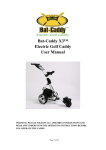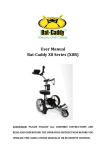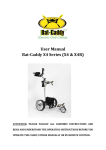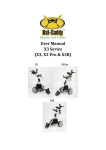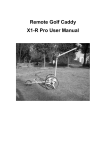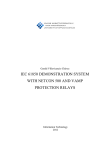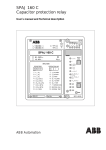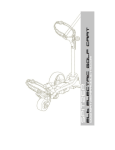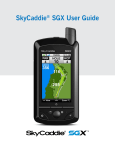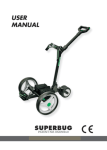Download Golf Caddy User Manual
Transcript
Bat-Caddy X4R™ Remote Controlled Electric Golf Caddy User Manual WARNING: PLEASE FOLLOW ALL ASSEMBLY INSTRUCTIONS AND READ AND UNDERSTAND THE OPERATING INSTRUCTIONS BEFORE YOU OPERATE THE CADDY, EITHER MANUALLY OR BY REMOTE CONTROL. Page 1 of 16 TABLE OF CONTENTS Page 1. 2. 3. 4. 5. 6. Packing List & Parts Glossary Assembly Instructions Operating Instructions General Maintenance & Other Instructions Technical Specifications Frequently Asked Questions 1. Packing List Standard Parts 1 x Caddy Frame 1 x Anti-Tip Wheel & Pin 2 x Rear Wheels 1 x Battery Pack (Battery, Bag, Leads) 1 x Charger 1 x Tool Kit 1 x Remote Control 1 x Scorecard Holder 1 x User Manual, Warranty, Terms & Conditions Optional Accessories Cup Holder Umbrella Holder Carrying Bag Rain Cover Sand Dispenser Page 2 of 16 2 4 6 10 13 15 1. 2. 3. 4. 5. 6. 7. Manual Rheostat Speed Control Upper Bag Support Bag Support Strap Battery Rear Wheel Wheel Hubcap Rear Wheel Quick Release Catch 8. Dual Motors 9. Lower Bag Support & Strap 10. Front Wheel 11. Upper Frame Locking Knob 12. Handle IC Controller 13. Battery Plug 14. Front Wheel Tracking Adjustment 15. Scorecard Holder 16. Lower Frame Locking Knob Page 3 of 16 2. Assembly Instructions Unpack all items carefully and check parts 1. Place frame structure (one piece) on soft and clean ground to protect frame from being scratched. Attach wheels to axles by pushing wheel locking button on the outside of the wheel and inserting the axle extension into the wheel. Make sure to keep the locking button on the outside of the wheel pushed in during this process, in order to enable the axle extensions, including the two pins, to be inserted all the way into the wheel. If not locked in, the wheel will not be connected to the axle and will not be propelled!!! Test the lock by trying to pull the wheel out. To disassemble the wheels proceed in reverse order. 2. Erect Frame by unfolding and connecting the main frame tubes together at the two frame locks by fastening the lower and upper frame locking knobs. Proceed in reverse for folding the caddy. Page 4 of 16 3. Place battery pack on battery tray and fasten Velcro straps around battery tightly. Insert battery plug into caddy outlet. Note: BEFORE CONNECTING make sure that caddy power is OFF, Rheostat Speed Control on handle is in OFF position and the remote control is stored securely!!! 4. Insert anti tip wheel into holding bar on motor housing and secure with pin. 5. Install Scorecard Holder and other accessories, such as beverage or umbrella holder onto the frame or handle in the foreseen places or receptors. (note: accessory design might vary during the model year) Page 5 of 16 3. Operating Instructions 3.1. Handle Control Functions – Design A 1. The rheostat speed button on the right side of the handle lets you choose your preferred speed seamlessly. Dial forward to increase speed. Dial backwards to reduce speed. 2. Press ON/OFF power button for about 2 seconds to turn caddy on or off 3. The Digital Cruise Control: Select the ideal speed to match your pace. In order to stop press the red cruise control button on the top of the handle. The cart will remember its last speed setting when you stop. Once you are ready to go press the button again, and the caddy will automatically travel at the same speed, except if you change the speed knob position. 4. The caddy is equipped with a "Soft start" ability which ensures smooth acceleration up to selected speed by pressing the stop/start button on the handlebar control panel. 5. The battery indicator LED with green or red color on the handle shows the battery charge at any time. 3.2. Handle Control Functions------Design B Page 6 of 16 1,Timer: Press 'timer' one time ,the trolley will move 10m/y and stop Press 'timer' two times, the trolley will move 20m/y and stop Press 'timer' three times, the trolley will move 30m/y and stop (Note: while the trolley moving, you can press the 'timer' button again and the preset distance will be Increased by an additional 10m/y) 2 ON/OFF and GO/STOP Function: A. ON/OFF Function: Press this button for 2 seconds to switch power on or off B. GO/STOP Function (Cruise Control): Press this button and the trolley will stop, press it again and the trolley will move at the previous speed 3.3. Remote Control Operation 3.3.1. Basic Remote Functions A. Brake/Stop: The red button in the center of the directional arrows should be used for braking/stopping the caddy. B. Timed Advance Distance Control: 10, 20, 30 meters/yards (press once/twice, three times consecutively; same as manual control timer function) C. Forward Arrow: Pressing the forward arrow will set the caddy in forward motion. Increase speed by pushing multiple times. Decrease reverse speed by pushing forward arrow. D. Reverse Arrow: Pushing the reverse arrow will set the caddy in backward motion. Pushing multiple times will increase the speed. Decrease forward speed by pushing reverse arrow. E. Left Arrow: Initiates left turns. When the arrows are released the caddy stops turning and continues straight with the original speed prior to turning. F. Right Arrow: same as left arrow function Page 7 of 16 3.3.2. Important Notes – PLEASE READ CAREFULLY Change the remote control batteries once the indicator LED gets weak The remote control uses two 1.5V AAA batteries available in any supermarket, drug store or electronics store It is recommended to keep a set of extra batteries ready as replacement To change the batteries open up the battery compartment cover and place the batteries according to the diagram in the battery compartment. Do not pull out the antenna with force, as it might break The remote control system is designed, so it does not interfere with other electric caddies. The maximum range of the remote control varies between 80-120 yards, depending on the battery charge, obstacles, atmospheric conditions, power lines and the topography of the course. It is strongly recommended to operate the caddy at a maximum range not exceeding 30-50 yards in order to prevent the loss of control of the unit! 3.4. Additional Functions 3.4.1. Freewheeling Mode The caddy can be easily operated without power. In order to activate the freewheeling mode, turn main power Off. The caddy now can be pushed manually without resistance. The freewheeling mode on some models can also be activated by pulling out both rear wheels by 1/2 inch (1cm) and relocking them back into the second axle groove. Some models are equipped with both options. 3.4.2. Controller/Remote Frequency Synchronization Sometimes it might be necessary to synchronize a new remote transmitter with the caddy: Turn the caddy power On, press either forward or reverse button for about 10 seconds while aiming the remote at the caddy. The caddy should start moving now. NOTE: It is recommended to remove the rear wheels or jack up the caddy before the synchronization process to prevent it from getting away. Page 8 of 16 3.4.3. Tracking Adjustment: Tracking behavior of all electric caddies is strongly dependent on equal weight distribution and slope. Test your caddy’s tracking by operating it on an even surface without the bag. If changes are necessary you can adjust the tracking of your caddy by loosening the front wheel axle and the adjustment bar on the right side of the front wheel and shifting the axle accordingly. After adjustment fasten screws in reverse order. 3.5. Electronic Systems Remote Control Range: We recommend not to exceed 50 yards distance. The greater the distance between you and caddy, the greater the chance of losing contact with it Microcomputer: The remote caddy has 3 microcomputer controls: The first is in main controller box. The second is in the remote control handset, and the third is in the handle. Safety Protection: When the temperature of the controller box reaches its upper limit in case of an overload it will automatically shut down to cool off. Microprocessor Controlled Electronics System: When you connect the battery, the electronics system will automatically run through a start-up routine. Then you can press the main OFF/ON switch on the handle. The battery charge indicator lights will show you the charge level of the battery from green (fully charged) to red (discharged). Important: The electronics controller box contains no user serviceable parts. Therefore, it is sealed to reduce the risk of moisture entering and impacting the electronic system. Breaking this seal increases the risk of damaging the electronics and decreasing the reliability of your caddy. DO NOT attempt to open the controller case. Doing so will void the warranty! Battery Operation and Care: Follow battery charge and maintenance instructions. The battery comes with leads and connector and a 30 or 40 Ah fuse. Page 9 of 16 4. Maintenance and Additional Instructions a) b) c) d) e) f) 4.1. PLEASE OBEY THESE PRECAUTIONS FOR BATTERY USE & CHARGING Please do not charge the battery in a sealed container or in upside down position. It is recommended to charge the battery in a well ventilated area. Please do not charge the battery near a heater, or where heat accumulation may occur or in direct sunshine. In order to prolong the service life of the battery, please avoid complete discharge and charge the battery after every use. Unplug the battery from the charger once the charge is complete. When the trolley is not in use for an extended period of time, it is recommended to charge the battery once a month. The battery’s poles red color stands for positive, and the black for negative. In case of battery replacement please reconnect the poles of the battery correctly. Otherwise your caddy could suffer severe damage. Please do not disassemble the battery or throw it into a fire. EXPLOSION!!! NEVER TOUCH THE ELECTRIC POLES OF THE BATTERY!! SAFETY HAZARD!! Battery Charging & Maintenance Connect the battery cable plug with the charger and then plug the charger into an electrical outlet. During the charging cycle the LED on the charger will show a blinking green light (some charger models also have a red steady light during charging). Once the charging cycle is complete the blinking green light or the red light will turn into a steady green light. It is now okay to unplug the charger and battery for reuse. The charging cycle can last up to 12 hours depending on the level of discharge. Normally the battery will hold its charge for several months, and it does not have a “memory effect”, and therefore can be recharged at any discharge level. It is not recommended to fully discharge the batteries, as this will shorten battery life drastically. The battery has a normal lifespan of 150-200 charges, depending on charging frequency, storage conditions and time and discharge history. Before storing a battery for extended periods of time you must fully charge it. DO NOT store an empty battery or else it might become unusable. Replacement batteries are available from your authorized Bat-Caddy dealer or directly from Bat-Caddy. Note: Life of sealed lead acid and any other batteries is dependent on a variety of factors, other than purely the number of charges, including but not limited to frequency between charges, duration of charge, level of drainage, idle time, storage conditions and duration and overall shelf time. We cover our batteries according to our warranty policy and any potential additional coverage is at our discretion. RECOMMENDATIONS FOR BATTERY CHARGING & MAINTENANCE a. Fully charge the battery for ca. 12 hours before the first use b. Do not leave the battery on the charger if it is not used for extended periods of time, but remove it from the charger after charge is complete. c. The battery will take approximately 2-3 rounds and charging cycles before it reaches its full operating potential. During the first couple of rounds it might still be below its optimal power. d. Always keep your battery fully charged before another game e. Never keep your battery connected to the grid during prolonged power outages. It might be irreversibly damaged f. Do not fully discharge the battery by “overplaying” it. It is recommended to recharge the battery after every 18 holes. Page 10 of 16 4.2. Test Caddy a. Testing Environment & Conditions First, make sure that you perform your first test of the caddy in a wide and safe area possibly on even surface, free of obstructions or valuables, such as people, parked automobiles, flowing traffic, furniture or water bodies (rivers, swimming pools etc.), steep hills, cliffs or similar hazards. b. Manual Control Operation Test the manual function first: Turn the caddy on. The manual speed functions of the caddy are controlled through the rheostat speed control wheel on the right side of the handle. Pushing the wheel forward (clockwise) will control the forward movement of the caddy. In order to slow down or stop the caddy, turn the wheel backwards (counterclockwise). c. Remote Control Operation Make sure you are close to the caddy at all times while testing it and familiarizing yourself with the remote control!!! Now turn the caddy on, and make sure that the rheostat control wheel is in Off position. One touch of the Forward/Backward arrows on the remote control starts the caddy in either direction. Further pushes will increase the speed. In order to stop the caddy press the round red STOP button in the center of the remote!! To slow down the caddy press the Reverse Arrow button. To turn the caddy in either direction, push the left or right arrows briefly. Once you release the left/right directional buttons the caddy will continue in the current direction at the same speed prior to the turning command. You will notice that the caddy reacts promptly to any turning command, so it will take you some practice to get just the right touch for proper and smooth turning maneuvers. Please be aware that the turning characteristics will change depending on the surface (grass, asphalt), the slope or the weight (loaded, unloaded) of your caddy. The remote is designed to have a reach of approximately 80-120 yards, but we strongly recommend to operate the caddy in closer ranges of 10-30 yards (not exceeding 50 yards) to be able to react to any unforeseen events, such as other golfers crossing your path or to avoid hidden obstructions (creeks, bunkers, GUR, etc.) or an unexpected disconnection in remote operation. An additional safety feature of this caddy is that it will stop moving if it does not receive a signal from the remote control at least every 30-40 seconds. This way, should you ever be distracted, your caddy does not get away. By pressing the lower center timed distance control button on the remote once, twice or three times the caddy can be moved forward automatically by 10, 20 or 30 meters/yards. NOTE: we strongly recommend to be in reaching distance of the caddy when operating it near bodies of water, creeks, bridges, public traffic or other hazards to avoid loss of control and equipment damage. The warranty will not cover accidents or damage caused by careless operation of the equipment or loss of control of the unit. 4.3. Recommendations for Efficient and Safe Operation Be alert and act responsibly at all times while operating your caddy, just as you would when operating a riding cart, motor vehicle or any other type of machinery. We absolutely do not recommend the consumption of alcohol or any other impairing substances while operating our caddies. Do not operate the caddy with the remote control in narrow or dangerous spaces, places with valuables or any people gathering areas, such as parking lots, close to flowing traffic, bag drop-off areas, stores, driving ranges, Page 11 of 16 4.4. With its optimized balance and straight front wheel the caddy has extraordinarily narrow and responsive turning and maneuvering abilities. However, it sometimes tends to react to uneven weight distribution of its load or slope variations and will follow the weight and the slope of the golf course, which is normal for electric caddies. Therefore, please make sure that the weight in your bag is distributed evenly (move heavy balls and items to both sides equally and to the upper part of your bag, or shift the bag on the caddy). Also, when operating your caddy by remote control anticipate the slope of the course in order to avoid frequent corrections in direction. In some extreme environments, such as very uneven terrain, steep hills, narrow and/or sloped cart paths, muddy areas, gravel paths, close to bunkers and hazards, around bushes, roots and trees it is recommended to operate the caddy via manual control in order to prevent any collisions, damage or the need for complicated correction adjustment maneuvers. When operating the caddy often in bumpy terrain we recommend to add an additional bungee strap to the lower and/or upper bag support to give the golf bag additional hold and prevent it from shifting. Please avoid or minimize operation on hard and rough surfaces, such as cart paths, asphalt roads, gravel roads, roots etc., as this will cause unnecessary wear and tear on tires, wheels and other components. The caddy is best operated on soft and smooth surfaces such as fairways. General Maintenance The steps below will ensure that you get a prolonged and reliable life out of your Bat-Caddy. 1) The Caddy has been designed so that the user can concentrate on playing golf, while the caddy does the work of carrying your bag. In order to keep your Bat-Caddy looking at its best, we advise that you wipe any mud or grass from the frame, wheels and chassis after every round with a damp cloth or paper towel. 2) Do NOT use hoses or high-pressure jet washers to prevent moisture entering the electronic systems, motors or gear boxes of the caddy. 3) Remove the rear wheels every few weeks and clean out any debris that might cause the wheels to drag. You might also apply some lubricant, such WD-40 to keep moving parts smooth and corrosion free. 4) A 4-5 hour round of golf played once a week for 12 months is equivalent to ca. four years use of a lawn mower, so please inspect your cart at least once a year thoroughly, and if you notice any symptoms of wear, contact your Bat-Caddy Service Center. Alternatively, you can have your caddy inspected and tuned by our Service Center, so it’s always in great shape for the new season. 5) Always disconnect the battery when you store the caddy, and always put your caddy together before re-connecting the battery. If you are not planning to play for at least a month, store the battery in a warm and dry place (not on concrete floor) and don’t leave it on the charger. All of these recommendations and common sense will help keep your Bat-Caddy in top condition and ensure that it remains your reliable partner, both on and off the links. Page 12 of 16 5. Technical Specifications Bat-CaddyX4R Feature Specification Speed Control Motor Drive Train Battery Charger Weight Speed Distance/Range Maximum Load Climbing Ability Dimensions: Folded Power: 2 x 200 Watt (400 Watt) 12 V DC Electric Rear Wheel Drive, Dual Stainless Steel Gears (17:1 ratio) Dual independent transmission Power: 12V, 36 Ah Sealed Lead Acid Average Charge Time: 4-6 Hours Lifetime: ca. 150 - 200 charges* Input: 110-240V AC Output: 12V/3A-4A DC Trickle Charger Net Weight Caddy: 24 Lbs (11kg) Net Weight Battery: 25 Lbs (11 kg) Total Net Weight: 59 Lbs (22 kg) 6 m/h (9.6 km/h) ca. 13 m/27+ Holes/6-8 Hours 77 Lbs (35kg) 30 degrees Anti-Tip Wheel included Dimensions: Unfolded Remote Control (range up to 80-120 Yards) plus Manual Rheostat Control Function: Forward, Reverse, Left & Right Cruise Control Timed Advance Function (10, 20, 30 m/y) Length: 42-50" (adjustable handle) Width: 21" Height: 35-45" (adjustable handle) Length: 33" Width: 21" Page 13 of 16 Rear Wheels Height: 10" Airless, rubberized thread Quick Release Mechanism Diameter: 11.5" Front Wheels Materials Colors Complimentary Accessories Frame: Aluminum, Stainless Steel Bag Support: Steel Oxidized Silver Scorecard Holder Cup Holder Seat Umbrella Holder Carrying Bag Rain Cover Sand Dispenser Optional Accessories Warranty Packaging Airless, rubberized tread Tracking Adjustment 1 Year on Parts & Labor 180 Days/150 Charges on Battery Type: Cardboard Box, Styrofoam Cushioning Dimensions: 32 x 24 x 12” (83 x 62 x 31 cm) Gross Weight: 55 Lbs (25 kg) Note: Bat-Caddy reserves the right to modify/upgrade any components during a model year. Hence illustrations on our website, brochures and manuals may vary from the actual product shipped. However, Bat-Caddy guarantees that specifications and functionality will be always equal or better from the advertised product. Promotional accessories may also vary from illustrations shown on our website and other publications. Page 14 of 16 6. Frequently Asked Questions (FAQ) In order to provide our customers with the most accurate and in-depth information please read below some answers to the most frequently asked questions. Should I charge the battery once I receive the unit? Bat-Caddy: Our 12V sealed lead acid batteries come more or less fully charged, but we recommend to charge them for a full 12 hours before the first usage. The charger should either have a blinking green light or a red light while it's charging and turn into a steady green light when the battery is fully charged. The batteries develop their full potential after a few full charging cycles. How long does the battery last? Bat-Caddy: Our batteries are rated to last on average for 27 holes or 6-7 hours of play per charge. Depending on the weight and topography of your course they might last longer or shorter. However, we recommend recharging the battery after every 18 holes, as complete drainage reduces the life time of a battery significantly. What do the lights on the handle mean? Bat-Caddy: The red, yellow and green LEDs on the handle indicate the level of charge of the battery. When the battery is fully charged they all should be lit. As the battery drains itself first the green, then yellow will go off. If only the red is on it's time to recharge. My caddy has no power when I try to turn it on? Bat-Caddy: Please check if all electrical connections are tight. Also check the fuse in the red cable of the battery leads within the battery carrying case. If broken please replace with a standard 35Amp automotive fuse. My caddy tends to track to one side. What should I do? Bat-Caddy: All caddies will follow weight and slope. If the weight in your bag is unevenly distributed the caddy will always tend to track to that side. Make sure that your bag is balanced. Please test the tracking of your caddy without the bag on even terrain. The tracking can also be adjusted by adjusting the front wheel. Please open the axle screw and the tracking rod located on the right side of the front wheel. Shift the wheel as needed and tighten the screws in reverse order. Do caddies interfere with each other when playing with other Bat-Caddy carts? Bat-Caddy: No. the remote controls have slightly different frequencies, so they don't interfere with each other. I lost my remote control and just received a replacement. How do I reprogram the unit? Bat-Caddy: In order to resynchronize a new remote control you need to turn the caddy on and press either forward or reverse on the new remote while aiming it at the caddy for 5-10 seconds until the remote tunes in and the caddy moves The manual control function works, but the remote control does not? Bat-Caddy: Please confirm that the rheostat speed knob is in Off or Stop position. Also check the batteries in your remote control handset. If it still does not work open up the remote control and check the connections. Page 15 of 16 The caddy does not respond well to the remote control handset? Bat-Caddy: Please check the fit and condition of the handset batteries. Make sure you don’t exceed the range distance limit. The trolley stops by itself sometimes? Bat-Caddy: Please check the battery charge level. Also the controller box has a shut-down function, if the battery is too low or the controller is overheating or the caddy does not receive a signal for 30-40 seconds. Whom do I contact for service, parts and technical support? Bat-Caddy: Please contact our Bat-Caddy Service Center at 1-877-815-0809 or 1-888-214-6033 or send an e-mail to [email protected] Bat-Caddy® is a registered trademark of SpaCom LLC Copyright - All Rights Reserved Bat-Caddy Page 16 of 16
















